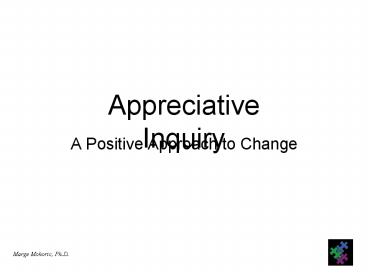Appreciative Inquiry - PowerPoint PPT Presentation
1 / 23
Title:
Appreciative Inquiry
Description:
Appreciative Inquiry A Positive Approach to Change – PowerPoint PPT presentation
Number of Views:76
Avg rating:3.0/5.0
Title: Appreciative Inquiry
1
Appreciative Inquiry
- A Positive Approach to Change
2
- "Man does not weave this web of life. He is
merely a strand of it. - Whatever he does to the web, he does to himself."
- Chief Seattle - 1854
3
David Cooperrider
- Original theory and vision for AI while he was
professor at the Weatherhead School of Management
(along with Suresh Srivastva, 1987) - AI is about creating a positive revolution in
change - Professor Robert Quinn, in his acclaimed book
Change the World concludes that AI is currently
revolutionizing the field of organizational
development
4
New Realities
- Problems are often the result of our own
perspectives and perceptions - If we look at a certain priority as a problem,
then we tend to constrain our ability to
effectively address the priority - Knowledge is the new currency
- Whole systems can change
5
AI Process
- Appreciative Inquiry (AI) is a process for
engaging people across the system in renewal,
change and focused performance.
6
AI Process
- The basic idea is to build organizations around
what works, rather than trying to fix what
doesn't.
7
AI Process
- A proven benefit of the approach is its reliance
on the acknowledgement of contribution at the
individual level, which leads to trust and
organizational alignment.
8
AI Process
- The method creates meaning by drawing from
stories of concrete successes and lends itself to
cross-industrial social activities.
9
Work Climate Survey
- Provides a snapshot of employees opinions about
what its like to work at your organization.
10
Why conduct a climate survey?
- (Sample organizational Vision)
- We are committed to building a workplace that
supports employees, customers, and owners in
reaching their aspirations.
11
- Problem-Solving
- Perceived Need Identification of Problem
- Analysis of Causes
- Analysis of Possible Solutions
- Acton Planning
- ContextA Problem to be
- Fixed
- Appreciative Inquiry
- Appreciating the Best of What Is
- Envisioning What Might Be
- Designing What Should Be
- Delivering What Will Be
- Context A Mystery to be Uncovered
12
Problem-Based Approach
- Process is inherently slow, limiting
- Focuses attention on yesterday
- Creates defensiveness, lack of honesty
- Promotes vocabulary of human deficit
- Often leads to fatigue rather than sustained
effort
13
AI One Goal
- Discovering the root cause of success
14
AI Two Laws
- 1. What you seek is what you find.
- 2. Where you believe you are going is where you
will end up.
15
AI Three Principles
- 1. Change starts the minute you begin asking
questions - 2. Positive images of self lead to positive
action - 3. Negative images of self lead to negative
action
16
The AI Change Process
Discover
AFFIRMATIVE TOPIC CHOICE
Deliver
Envision
Design
17
AI Change Process
- Appreciative Inquiry utilizes a 4-stage process
focusing on - DISCOVER The identification of organizational
processes that work well. - DREAM The envisioning of processes that would
work well in the future. - DESIGN Planning and prioritizing processes that
would work well. - DELIVER (or CREATE) The implementation
(execution) of the proposed design.
18
Affirmative Topic Choice
- Set conversations in affirmative terms.
- Provoke bold ideas on 4-5 topics.
- Demonstrate an authentic desire to learn,
discover, grow. - Evoke dialogue about desired future.
19
Selecting Affirmative Topics
- Based on your review of the climate study
findings, what things, if changed, would move
your organization closer to becoming an ideal
organization in which to work? - (State these things in the present tense)
20
AI Interview Protocol
- FOUR KEY QUESTIONS
- High Point / Peak Experience
- Things Valued Most About
- Core Factor that Gives Life to Organization
- Images of Future Possibility
21
Typical Decision Points
- What topics to select?
- Who is involved?
- How many appreciative interviews?
- How do we want to engage people in the dream and
design phases?
22
Sources
- David Cooperrider and Diana Whitney (2005)
Appreciative Inquiry a positive revolution in
change - Theodore Kinni, The Art of Appreciative Inquiry,
The Harvard Business School Working Knowledge for
Business Leaders Newsletter, September 22, 2003.
(2) - Marge Mohoric, Ph.D., Organizational Development
Practice www.theparagongroup.com
23
Dialogue Philosophical Context
- Martin Buber places dialogue in a central
position in his philosophy he sees dialogue as
an effective means of on-going communication
rather than as a purposive attempt to reach some
conclusion or to express some viewpoint(s). - David Bohm originated a related form of Dialogue
where a group of people talk together in order to
explore their assumptions of thinking, meaning,
communication, and social effects. This group
consists of ten to thirty people who meet for a
few hours regularly or a few continuous days.
Dialoguers agree to leave behind debate tactics
that attempt to convince and, instead, talk from
their own experience on subjects that are
improvised on the spot.






























